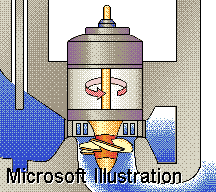
| |
 |
![]()
If you live in a hilly area where there are small streams, you can develop a very adequate power system with very little flow. This is called a High Head System and it involves as little as a 50 foot drop with only a one gallon per second flow to yield an average power of a steady 300 watts. This is enough power to drive your lights and other small appliances. With a battery support, or flywheel or spring support, you'll be able to develop a really adequate power system for almost no money and at very little expense. You want to use the batteries to store power during the period of little use from 10 PM to 6 AM.
A small dam is set up about 4 feet high and 12 feet wide with logs and rock. At one point there is a spillway for the major amount of water, and at another a gate that opens into a canal (race) leading to another much smaller dam and a smaller spill way. From this dam, a penstock (PVC pipe) runs downwards at least 50 feet to the power house. The longer the head run (and the steeper the fall) in the PVC pipe, the faster the water will move through the pipe and the less the actual flow has to be. Steep falls beyond 45 degrees will often require sharp bend in the pipe, and thus reduced head. Also a steep fall will encourage objects to move into the turbine. Sometimes a filtering barrel is put in the top of the penstock to stop trash that could clog the penstock in the middle, requiring dismantling it. In the winter time it needs to be heavily insulated or buried below the frost line.
 But in any case, you can vary the output by the diameter of the pipe, the length of
the pipe, and the amount of water you can get into the pipe. It relies on a large
vertical drop rather than a large volume of water. Thus a power plant near a small
stream waterfall, or a contrived water fall. The endpoint generator for this system
is called a Pelton Turbine. These operate best with head of 50 feet or more. The
high velocity jet of the water speeds the turbine runner at high speeds that don't
require expensive additional gearing. These runners can be as big as 12 ft. in
diameter for million watt installations or down to 18 inches for small home
installations. No more water than that which comes from a modest spring will run
one. A model that is even smaller and faster than Pelton Turbines is the Turbo Turbine where the incoming
water jet is oriented at an angle to the turbine blades.
But in any case, you can vary the output by the diameter of the pipe, the length of
the pipe, and the amount of water you can get into the pipe. It relies on a large
vertical drop rather than a large volume of water. Thus a power plant near a small
stream waterfall, or a contrived water fall. The endpoint generator for this system
is called a Pelton Turbine. These operate best with head of 50 feet or more. The
high velocity jet of the water speeds the turbine runner at high speeds that don't
require expensive additional gearing. These runners can be as big as 12 ft. in
diameter for million watt installations or down to 18 inches for small home
installations. No more water than that which comes from a modest spring will run
one. A model that is even smaller and faster than Pelton Turbines is the Turbo Turbine where the incoming
water jet is oriented at an angle to the turbine blades.
Cost:if you do all the work yourself from lots of native materials, and don't have too many back-up batteries, you might be able to put the whole thing together for 300 watts power for maybe around $2,000.